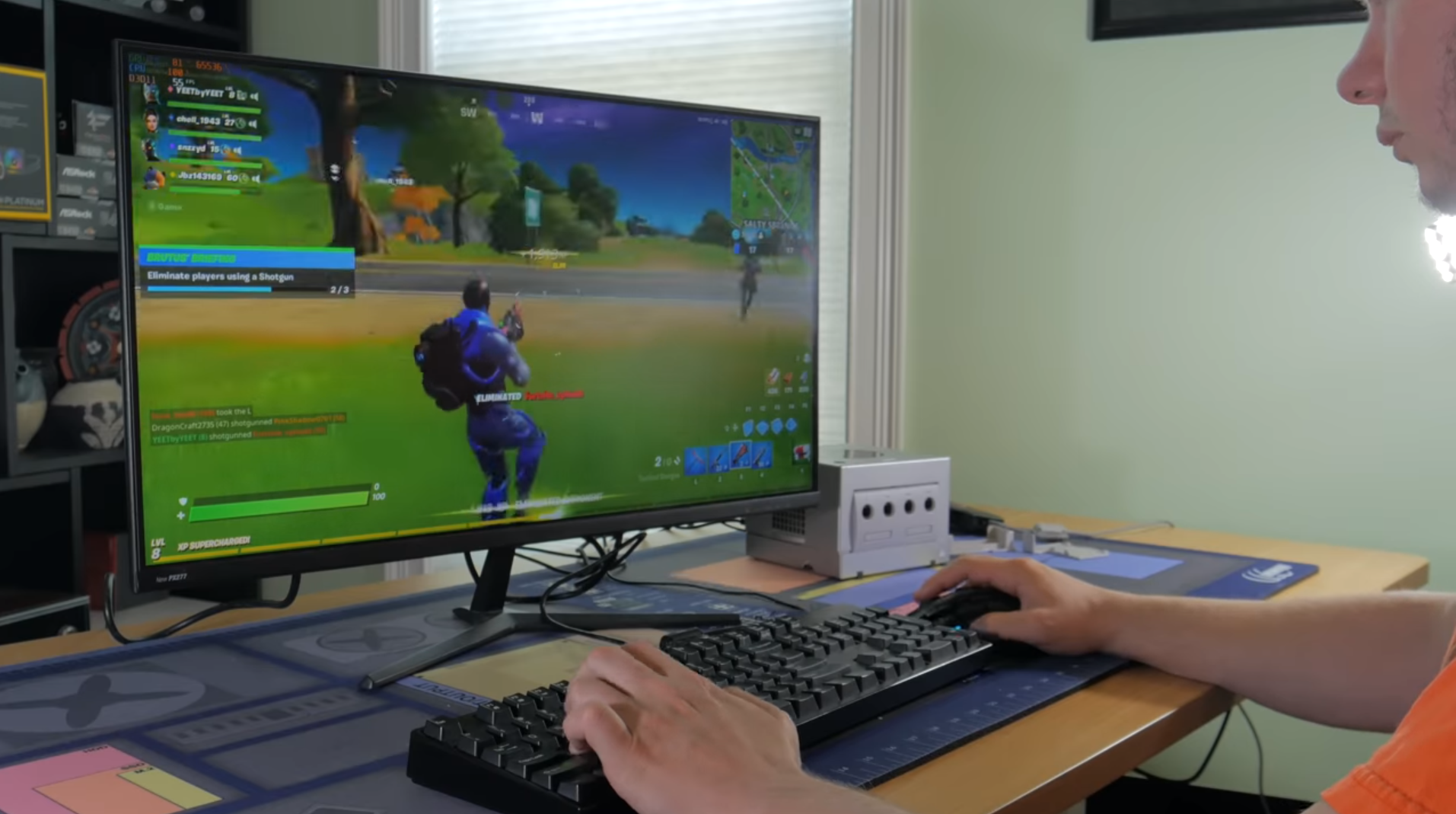PC Builder Mods a GameCube Into an AMD-Powered Gaming Desktop
It looks like a slightly beat-up NIntendo GameCube, but it can run Smash Brothers. No, not Super Smash Bros. Melee from 2001 -- the more recent Super Smash Bros. Brawl for the Wii. Yes, it looks like an obsolete gaming console, but it can also play Far Cry 5 and Fortnite. That's because this GameCube was modded by a YouTuber known as Tech by Matt and turned into a sleeper gaming PC.
Shared on YouTube and spotted by The Gamer, Tech by Matt employed an AMD Ryzen APU and other PC components to turn an old GameCube in to a PC build that specializes in packing modern power into modest chassis, rather than the best PC cases, often taken from pre-built computers. It's primary focus is emulation, eSports and looking perfectly retro (is the early 2000s 'retro' yet?).
Instead of flaunting RGB, sleeper gaming PCs are about looking as unassuming as possible, nd making machines that outperform expectations. Matt specializes in this kind of build, and his latest experiment is a direct hit to PC gaming elitists.
Half case mod and half cannibalization, the GameCube sleeper PC is complete with working controller ports. Built inside a modified GameCube case, space is at a premium, meaning that while its power is leagues above an actual GameCube and it can technically run more modern AAA games, it’s not going to run games smoothly at 4K specs anytime soon. Still, it's a unique approach to playing both your old favorites and your less demanding recent titles.
Components
Parts for the build are half original and half salvaged from the ASRock DESKMINI A300W. Original parts are an AMD Ryzen 3 3200G, 16GB of laptop-style SODIMM DDR4 RAM, a single 500GB NVMe SSD and a 50mm fractal design fan. Parts salvaged from the ASRock DESKMINI include an “almost comically small” A320 mini-STX motherboard, a cooling fan, an M.2 Wi-Fi card and a 150W power brick.
Matt also bought a broken, slightly scuffed up (for that rough aesthetic) GameCube off eBay, along with a generic USB Gamecube controller adapter and a Gamebit screwdriver for removing the GameCube’s proprietary screws.
Tallying these parts together, we estimate a total cost of $420 for this build, though Matt mentioned that you could upgrade the Ryzen 3 to a Ryzen 5 if you want, and that the motherboard has room for another SSD. However, the parts listed suited his needs.
Get Tom's Hardware's best news and in-depth reviews, straight to your inbox.
The Building Process
Matt’s task was split into two parts: disassembling the GameCube and building the new PC.
For disassembly, Matt first used the GameBit screwdriver to open up the GameCube, easily removed the controller port and back panel, unscrewed 12 Phillips head screws to take out the combined side fan and power button. Then, with a bit more unscrewing, he was able to take out the disk drive, mainboard, power supply and a “few more metal pieces.” For the most part, Matt reported this was the easier part of the project, though he noted that the GameCube’s original heatsink had “a ridiculous amount of thermal paste.”
Assembly was trickier, especially because Matt wanted to use the GameCube’s original controller ports and power button in the new build. This meant hollowing out useless space-consuming indents that Nintendo left for expansions and cables from the GameCube’s bottom, making a custom metal tray to fill in the holes they left behind, installing his own motherboard standoff, and modding the original side fan bracket to fit with his new fan.
Matt also had to solder jumper cables to the original power button to plug into the new motherboard's power slot, as well as solder the Gamecube’s original controller port board to his adapter’s board, then connect the adapter’s board to his motherboard’s USB slots. He also considered adding a top-loading disk drive to the system, but abandoned the idea as fitting a disk drive into the case would have interfered with the power button, eject button and original disk drive hinge mechanism.
It’s more work than we make it sound like, and definitely enough to bump up the system’s cost a few hundred dollars if you don’t already have the tools and materials to do it, which include a dremel, soldering iron with cutting tip and low grit sanding wheel (Matt's video provides detailed instructions).
At the end of the build, though, Matt achieved what almost looks like an untouched GameCube from the outside, with enough power inside to run the Dolphin GameCube/Wii emulator and eSports titles without issue.
He didn't provide any emulation stats, but after testing the system with The Legend of Zelda: Twilight Princess, Super Smash Brothers Melee and Super Smash Brothers Brawl, he said they all “ran perfectly fine.” Fortnite, meanwhile, averaged 60 frames per second (fps) at 1080p on the game’s relatively low competitive settings, while CS:GO was able to reach an average fps in the lower 100s at 1080p on its own similarly low-spec competitive settings.
The PC...console...system...can also run more graphically intensive AAA games, though Matt warned that it “isn’t really meant for AAA gaming,” as it was only able to hit an average frame rate of 25 fps on Far Cry 5’s low settings. Matt also tried to emulate The Legend of Zelda: Breath of the Wild on the machine, and while the game didn’t crash, he did run into enough lag spikes to render it borderline unplayable. He noted, however, that Breath of the Wild is notoriously difficult to emulate, meaning that the system itself might not be behind these problems.
For someone like me, who’s recently gotten into emulating my GameCube and Wii collection on Dolphin to take advantage of its higher resolution options and convenience features, like save states, this is an appealing nostalgia build. It’s also more portable than your typical gaming PC, and the GameCube case even gives it a cute handle for carrying to your next LAN party.
Matt’s still taking requests for games to emulate on it, so stop by his YouTube channel if you’d like to see him try your personal favorite.
Michelle Ehrhardt is an editor at Tom's Hardware. She's been following tech since her family got a Gateway running Windows 95, and is now on her third custom-built system. Her work has been published in publications like Paste, The Atlantic, and Kill Screen, just to name a few. She also holds a master's degree in game design from NYU.
-
bit_user It'd be fitting if they could somehow stuff a POWER CPU and an AMD GPU in this thing.Reply
The real GameCube features a PowerPC CPU and an ArtX/ATI GPU. I believe that ATI group was later spun off and bought by Qualcomm to build their Adreno mobile GPUs. -
Evilbred Replybit_user said:It'd be fitting if they could somehow stuff a POWER CPU and an AMD GPU in this thing.
The real GameCube features a PowerPC CPU and an ArtX/ATI GPU. I believe that ATI group was later spun off and bought by Qualcomm to build their Adreno mobile GPUs.
PowerPC CPUs aren't X86 instruction set compatible. Also ATI was bought by AMD and forms their GPU divison, not Qualcomm. -
bit_user Reply
Yes, I'm well aware of that. You could run Linux on it, though.Evilbred said:PowerPC CPUs aren't X86 instruction set compatible.
I mean, Raspbery Pi's also aren't x86 ISA-based, and people seem to regard them as being pretty useful.
Yes, my bad. It turnsout it was a different ATI acquisition that was sold to Qualcomm and formed their Adreno GPU group.Evilbred said:Also ATI was bought by AMD and forms their GPU divison, not Qualcomm.
In 2006, ATI acquired BitBoys, adding additional talent and experience with vector graphics to their mobile and handheld graphics team.
After AMD's acquisition of ATI in 2006, AMD licensed their mobile graphics technology to Qualcomm in April 2007 who integrated it into their Snapdragon processor family under their Adreno brand name. AMD subsequently sold off the mobile handheld graphics division to Qualcomm in 2009 for $65M following an earlier sale of the Xilleon branch to Broadcom.
Source: https://en.wikipedia.org/wiki/Imageon
That said ArtX was also bought by ATI. I just got them mixed up with BitBoys.
ArtX was contracted in May 1998 to create the system logic and the graphics processor (code named Flipper) for Nintendo's fourth game console (code named "Dolphin"), which would eventually be launched as the GameCube. ...
They demonstrated their first integrated graphics chipset with a built-in geometry engine at COMDEX in the fall of 1999. It was built into the Aladdin 7 northbridge sold by ALi of Taiwan.ArtX was acquired by ATI Technologies, Inc. in February 2000 for $400 million in stock options.
Source: https://en.wikipedia.org/wiki/ArtX


